How Restaurants Are Transforming Through Crisis

It’s been three months since many of the country’s restaurants were forced to close their doors to dine-in patrons due to the spread of COVID-19. Many restaurants chose to temporarily suspend all service and were forced to lay off their entire staff, while others, especially small businesses that might not ever be able to open again if they shutter temporarily, opted to continue operating in hopes of being able to stay afloat.
Most of those restaurants were forced to throw their playbooks and menus out the window entirely and rewrite their business model in just a few days, including how they’d manage to stay open while maintaining CDC’s guidelines to keep employees and diners safe. Initially, many restaurants promoted their carryout offerings, as well as encouraging people to buy gift cards to use later, and to contribute to employee relief funds. But it was soon clear that, in order to survive the shelter in place order and the economy’s slow re-opening, they were going to need to completely reinvent themselves, and perhaps, permanently so. Luckily, if there’s one thing people in the restaurant business are good at, it’s thriving under pressure. Here are just a few creative ways some restaurants are keeping the lights on during this pandemic and as we slowly re-open.
Michelin-Starred Restaurants Are Going Casual
For most of us, dining out at Michelin-starred restaurants is something we save for special occasions since for every star an establishment is bequeathed, the price tag tends to rise. And though we would rather see every dining room, Michelin star or not, flourishing, it turns out there is one very small upside to this pandemic, which is that many Michelin-starred restaurants have pivoted their business models and are now offering more affordable, albeit it humbler, menus for takeout.

https://www.adobe.com/express/discover/templates/menu
Lazy Bear, a ticketed $300 per person supper club-style restaurant in San Francisco, will face a challenge when it comes to social distancing when it reopens since the current format of the restaurant requires guests to eat side-by-side with strangers at two long communal tables in front of an open kitchen. For now though, anyone can enjoy provisions from the Lazy Bear Camp Commissary, which offers breakfast, lunch, coffee, cocktails, wine, and pantry items to-go. On a recent Sunday morning, there were lines around the block (with people standing six feet apart, of course) of community members waiting to pick up dinner kits, egg and cheese sandwiches, and jars of cultured butter. Lazy Bear is keeping patrons posted about its Camp Commissary almost exclusively on Instagram with notes about menu additions, photos of dishes, and a promise that it is still using the best Bay Area ingredients “not only because they are delicious, but because [they] want to support [their] favorite purveyors and make sure they are still around to keep supplying us with awesome stuff when this quarantine is over!”
In general, the consensus with these high-end restaurants is that, in order to keep business going, they need to offer more casual options that travel well and don’t require artful plating, which is why you can also get “Crenn Kits” to reheat at home from chef Dominique Crenn of Atelier Crenn in San Francisco, to-go boxes from Blue Hill in New York filled with produce, meat, and fish from its farming and fishing partners (with an option to donate a box to healthcare workers), and a $38 bento box from n/naka, L.A.’s two-Michelin-starred kaiseki restaurant that’s usually impossible to get into.
Not every restaurant with a Michelin star is going this direction, however. As reported by Eater New York, Masa, the most expensive sushi restaurant in America, is selling $800 boxes of assemble-yourself sushi (enough for four people) each week. Yes, that price tag is completely outrageous, but hey: it’s still significantly less than the $1500 you’d have to pay for dinner for two if you were dining at the restaurant.
Related: Check out free remixable menu templates!
Pizza and a Performance
Even with lots of delicious local pizza delivery options in most major cities, even in these trying times ordering a pepperoni pie can still feel more rote than rare, which is why some pizza spots are finding new ways to attract diners.
In honor of Poetry Month in April, San Francisco’s Goat Hill Pizza attached “pizza poetry” written by students at 826 Valencia, a non-profit dedicated to supporting under-resourced children with their writing skills, to all of its take-out orders. Diners were treated not only to some of the SF’s tastiest sourdough pies, but also poems like these which included each student’s name and age.
In keeping with the allure of art paired with food, Los Angeles or Las Vegas, Vampire Pizza is, ahem, sinking its teeth into the delivery game with an immersive experience that we hope sticks around long after things return to normal. The ghost kitchen pizza company delivers not only a tasty meal that includes a medium pizza, salad, and dessert, but also an interactive one-of-a-kind clue-based game created by furloughed artists and storytellers, and delivered by the Belle and her D-Vamps, the “vampire family” on which the game is based and who promise to treat “every customer like they’ve known them for centuries.” Just what each game entails is left a mystery, but Vampire Pizza uses Instagram to give would-be eaters and players a small hint of what to expect.
Of course, not everyone wants their pizza delivered by the undead, and rather than play an interactive game would prefer to bond with their shelter-in-place companions over a night of cooking, albeit without a stressful trip to the grocery store. Pizza parlors all over the country are heeding that cry and delivering DIY pizza-making kits with all of the ingredients, a perfect way to both bring in revenue and give families an evening activity.
Restaurants Turned General Stores
In many parts of the country, going to the grocery store right now requires waiting in long lines, face masks, lots of hand sanitizer, and, for many, an understandably significant amount of anxiety. While some cities offer grocery delivery, it’s nearly impossible to get a time slot, which is why some restaurant owners decided it made the most sense to transform their eateries into temporary general stores.
Anthony Strong, the chef and owner of Prairie, an Italian restaurant in San Francisco, was one of the first in the Bay Area to do this. Not only has this allowed him to help out his local community by giving them a place to buy the things they need, including pantry items, produce, meat, beverages (including house cocktails), masks, and cleaning supplies, but it’s also enabled him to keep all of his employees. “I haven’t laid one person off and I don’t plan to. Our bartender is packing boxes, our servers are ringing people up, and our cooks are pre-packaging and stocking.” Prairie features special offers, kits, and new items on Instagram alongside its new motto: “Shelter in Abundance.”
Programs like this are popping up at restaurants all over the country, including in Austin at Emmer & Rye where food, retail wine, and gourmet grocery items are available to-go, and boxed pantry kits are available to ship anywhere in the U.S.; Chicago where Bar Biscay is now Bodega Biscay and offers fresh produce, liquor and wine, and tons of in-demand baking goods; and New York City where Fort Defiance in Brooklyn is selling CSA boxes from a local farm, as well as other groceries. Even L.A.’s roaming food trucks are getting in on the grocery store game; The Coolhaus Shop, usually an ice cream truck, is now L.A. Bodega on Wheels, a “rolling bodega” selling food, beverages, snacks, produce, and pantry staples.
Business Gets Done on Social Media
Many of the businesses that were able to stay open for carryout orders had to remake the way they took orders and received payment in order to stay safe. Add the sudden nature of the pandemic, and there wasn’t much time to implement online ordering platforms. Instead, many businesses turned to social media–and especially Instagram–to conduct business over direct message.
Harmonic Brewing, for instance, invited food truck friends to set up shop outside its San Francisco taproom so they could all continue operating under a no-touch order and pick-up process, powered by social media. Customers placed orders over DM, paid with Venmo, and then picked up the order. Not only did Instagram remain a main channel for promoting menu options and deals, it offered an easy way to provide service without interruption. Plus, hungry scrollers could become customers with just a swipe of their finger.

https://adobesparkpost.app.link/Dwr2PrldE6
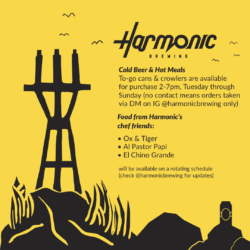
https://adobesparkpost.app.link/uTKN0audE6
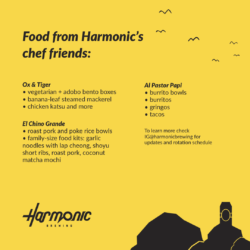
https://adobesparkpost.app.link/X38EFBqdE6
Tap to remix Harmonic Brewing’s designs above or browse more restaurant templates.
Get a Little, Give a Little
One of the most popular additions many restaurants have made besides switching to an entirely take-out and/or delivery model, is the option to buy a meal for yourself and someone in need. For many restaurants, this isn’t just a chance to bring in more money, but to give back to the community, especially healthcare workers.
One example of this is Che Fico Alimentari. The sister restaurant to hotspot Che Fico in San Francisco went this direction soon after as the stay-at-home order went in place. The restaurant relies on investors, supporters, and regulars to buy up to 200 dinners a night for those in need, which includes people whose jobs have been eliminated, hospital workers, and anyone else impacted by coronavirus, and relies solely on the honor system. The family meal (built for two to three people) is also available to purchase for $50 for those who can afford it. Menus are posted by 3pm every day on the restaurants’s instagram.
These efforts are being made by restaurants throughout the country, including New York, Los Angeles, Denver, San Francisco, Austin, and Chicago. For those who are able, it’s a satisfying way to not only get a delicious meal to enjoy, but to show healthcare workers how much they’re appreciated.
These are incredibly trying times for the restaurant industry, not only financially but mentally. Four out of 10 restaurants are closed and two out of three restaurant employees have lost their jobs. Of those restaurants that are closed, it is estimated that 20 to 30 percent will never reopen, and for those that do, the dining experience will likely be very different for months to come. Still, though the figures are devastating, people who work in the restaurant industry are some of the most innovative and resilient amongst us, and if anyone can turn lemons into lemonade, it’s them. Literally.
Your Turn! New Templates to Creatively Communicate
Do you have a restaurant and need to find some creative ways to get the word out to your customers about curbside takeout and delivery offerings? How about a social post to share about reopening plans or an employee relief fund? Here are a some new templates to get you started.
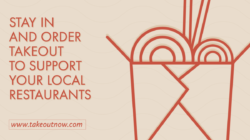
https://adobesparkpost.app.link/EWq1fpSSC6
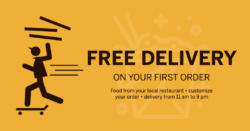
https://adobesparkpost.app.link/8prJ20WSC6
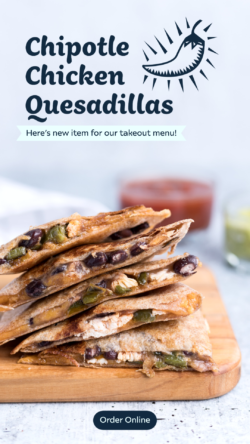
https://adobesparkpost.app.link/Uk4Je00SC6
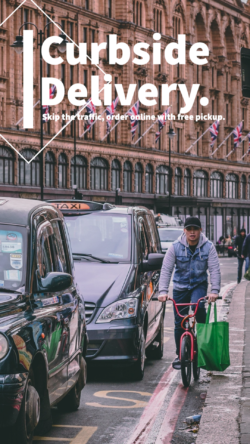
ttps://adobesparkpost.app.link/B8vzud9SC6
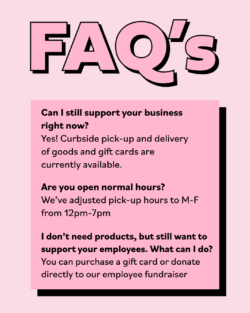
https://adobesparkpost.app.link/g7E1puhTC6
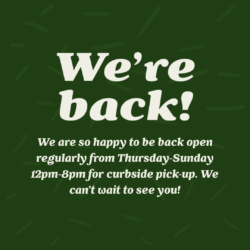
https://adobesparkpost.app.link/4sicijdTC6
More templates for staying safe and connected during Coronavirus. Tag #adobespark on social for a chance to be featured.
Daisy Barringer is a journalist covering food, drink, and hospitality in San Francisco.